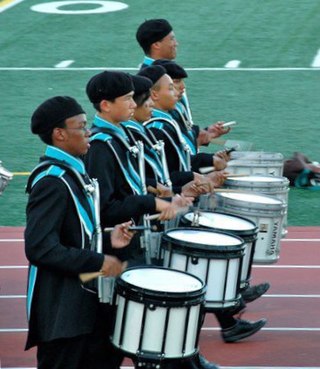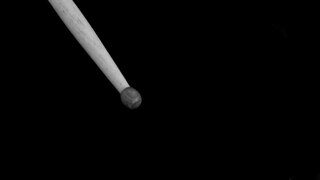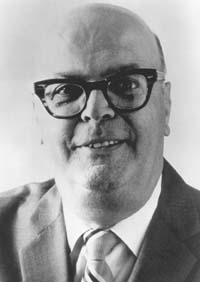Related Research Articles

The snare drum is a percussion instrument that produces a sharp staccato sound when the head is struck with a drum stick, due to the use of a series of stiff wires held under tension against the lower skin. Snare drums are often used in orchestras, concert bands, marching bands, parades, drumlines, drum corps, and more. It is one of the central pieces in a drum set, a collection of percussion instruments designed to be played by a seated drummer and used in many genres of music. Because basic rhythms are very easy to learn to play on a snare drum even for children, the instrument is also suitable for the music education for young children and a rhythm band.

Snare technique is the technique used to play a snare drum.

A drum roll is a technique used by percussionists to produce a sustained sound for the duration of a written note.
All drum figures are based upon three fundamental beats, technically called roll, single stroke, and flam...Sustentation is accomplished upon wind instruments by blowing into the instrument; it is accomplished upon the violin and the allied instruments by drawing the bow across the string; it is accomplished upon the drum and allied percussion instruments by the roll.
THE SNARE DRUM ROLL.
The roll consists of an even reiteration of beats sufficiently rapid to prohibit rhythmic analysis. To produce an impression of sustentation, these beats must be absolutely even both in power and in sequence. Uneven beats in a roll destroy the impression of sustentation. Evenness is then the primary quality to strive for in roll; speed is the secondary quality to strive for.
There are two possible ways of producing an absolutely even sequence: (1) hand alternation of single stroke and (2) hand alternation of double strokes...The snare drum roll is produced by hand alternation of double strokes.
The "open roll" is produced by [initially] slow hand alternation. Two strokes in each hand alternately are produced by wrist movement and each beat should follow its predecessor in clock-like precision.

Joseph Albert Morello was an American jazz drummer best known for serving as the drummer for pianist Dave Brubeck, as part of the Dave Brubeck Quartet, from 1957 to 1972, including during the quartet's "classic lineup" from 1958 to 1968, which also included alto saxophonist Paul Desmond and bassist Eugene Wright. Morello's facility for playing unusual time signatures and rhythms enabled that group to record a series of albums that explored them. The most notable of these was the first in the series, the 1959 album Time Out, which contained the hit songs "Take Five" and "Blue Rondo à la Turk". In fact, "Take Five", the album's biggest hit was specifically written by Desmond as a way to showcase Morello's ability to play in 5
4 time.

In rudimental drumming, a form of percussion music, a drum rudiment is one of a number of relatively small patterns which form the foundation for more extended and complex drumming patterns. The term "drum rudiment" is most closely associated with various forms of field drumming, where the snare drum plays a prominent role. In this context "rudiment" means not only "basic", but also fundamental. This tradition of drumming originates in military drumming and it is a central component of martial music.
Open, closed, open is a technique of playing snare drum rudiments, especially used during auditions or classical practice routines.
George Lawrence Stone (1886–1967) was an American drummer and author.
Sanford Augustus Moeller (1878–1960) was an American rudimental drummer, national champion, educator, and author. He was born in Albany, New York on February 16, 1878, and he began his music education by studying the piano.
Mitch Markovich is an American percussionist, composer, educator, and clinician in the areas of rudimental drumming, marching percussion, drum and bugle corps, and marching band. He is best known for his intensive marching snare drum solo compositions and record-setting performances, entitled "Tornado" and "Stamina", and for his percussion quartet composition entitled "Four Horsemen". Markovich's contributions to the style, notation, composition, and performance of percussion have endured over the last five decades.

Frank Arsenault was an internationally known American percussionist, teacher, and clinician in the areas of marching percussion, rudimental drumming, drum and bugle corps, and marching band. He was a full-time Staff Clinician and Educational Field Representative for the Ludwig Drum Company. He is also well known in his field for his signature playing style, for his many championship titles, and for his recording of The 26 Standard American Drum Rudiments and Selected Solos.
Charles "Charley" Wilcoxon was an American drum teacher and drum method book writer. He wrote several influential books on rudimental drumming that are still used by drum teachers today. He is a member of the Percussive Arts Society Hall of Fame.
Fritz Berger was a Swiss drum teacher and drum method book author. He wrote several influential books on Swiss rudimental drumming, or Basler Trommeln, that are still thought of as the authoritative sources for Swiss drumming in America.

William F. Ludwig was an American percussionist, drum-maker, and founder of Ludwig Drums. He helped to create the National Association of Rudimental Drummers and is a member of the Percussive Arts Society Hall of Fame.

Claus Hessler, also spelled Claus Heßler, is a German drummer, author, and teacher. He is a clinician who specializes in Open-handed drumming and rudimental drumming, especially Basel Drumming and Moeller method.
Gardiner A. Strube was an American drum major in the New York National Guard and the author of a fife and drum manual.
The National Association of Rudimental Drummers is an organization created to encourage the study of rudimental drumming. NARD is responsible for the creation of the Standard 26 American Rudiments.
Joseph Burns Moore was a champion rudimental snare drummer, member of the Connecticut National Guard, instructional author, and founding member of the National Association of Rudimental Drummers.
Jay Wanamaker is a percussionist and the president and CEO of Roland Americas and formerly held executive positions at Fender and Guitar Center. He also worked for Yamaha, Alfred Publishing, and the University of Southern California, and was chair of the Percussive Arts Society rudimental committee that published the 40 PAS Drum rudiments. He has also published over 50 music books and instructional DVDs.
John Sterling "Jack" Pratt (1931–2020) was an American Army drum instructor at West Point as well as a celebrated rudimental book author. Pratt produced several volumes of rudimental solos and instructional materials and was also the founder of the International Association of Traditional Drummers (IATD), a member of the National Association of Rudimental Drummers (NARD), a member of the United States Association of Rudimental Drummers (USARD), and was inducted into the Percussive Arts Society (PAS) Hall of Fame and the World Drum Corps Hall of Fame.
Roy Cecil Knapp was an American drummer and music educator. Known as "The Dean of American Drum Teachers", he founded the Roy C. Knapp School of Percussion in 1938. He was a longtime network orchestra member and sought-after studio musician skilled as a tympanist, percussionist and xylophone soloist. He performed on shows broadcast during radio's golden age in Chicago, Illinois and a founding member of the National Association of Rudimental Drummers (N.A.R.D.) formed in 1933.
References
- 1 2 "History of N.A.R.D."
- ↑ "Straight, Edward B." Archived from the original on 2021-08-16.
- 1 2 Straight, Ed. B. Edward B. Straight's drum corps method : the natural way to play. Oak Park: 1936.
- ↑ "NARD - National Association of Rudimental Drummers - the Standard 13 Rudiments - Rudimental Drumming".
- ↑ "On the varieties of stickings".
- ↑ Straight, Edward B. Edward B. Straight's improved pocket edition of The American drummer : important drum solos, military street beats. Chicago: 1908.
- ↑ Straight, Edward B. Edward B. Straight system of modern drumming : the easiest and most natural way to play drums : ragtime jazz and syncopation. Chicago: 1922.
- ↑ Straight, Edward B. The Straight system of modern drumming; the "natural way" to play drums: Lesson file. Chicago: Frank's Drum Shop, 1923.
- ↑ Straight, Ed. B. Etude No. 1: drum solo. Chicago: 1934.
- ↑ Ludwig, Moore, and Straight. The thirteen essential drum rudiments; Nine drums solos. Chicago: W.F.L. Co., c. 1951.
- ↑ "The Secrets of Chick Webb's Drumming Technique 1938". 4 October 2016.
- ↑ "Gene Krupa's Biography".
- ↑ "Eugene Bertram Krupa". 20 March 2015.